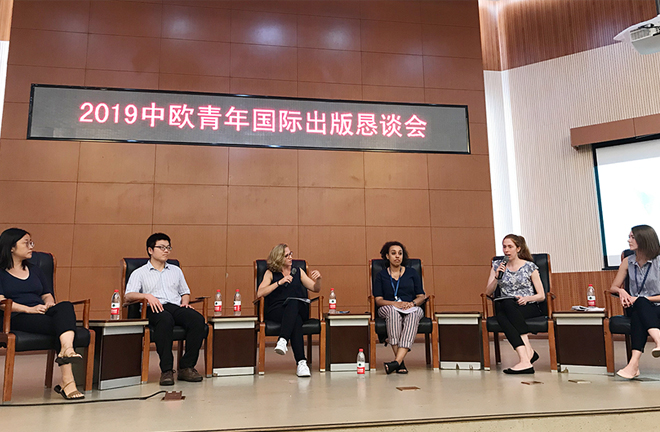Chinese publishers continue to seek more international readers

Young publishers at home and abroad share experiences of how to expand overseas markets and express the desire for cooperation. Photo: Chu Guofei/CSST
“The Influence Assessment on World-renowned Books from China (2019)” report was held on Aug. 19. This analysis of the performance of Chinese publishing agencies in the international market, based on the number of Chinese books in overseas libraries’ permanent collection, is now in its 8th year. The report identified a total of 24,168 new, distinct books including reprints, from 501 of the nearly 600 publishers in China’s mainland, that have been accepted by overseas libraries for permanent collection in 2019.
He Mingxing, a professor from the School of International Journalism and Communication at Beijing Foreign Studies University, said that in the last decade overseas libraries have consistently had large collections focused on Chinese contemporary literature, with the public libraries of North America being the largest and the most consistent collectors. However, the annual quantity of Chinese books (excluding their copies) in overseas libraries for permanent collection has declined for three consecutive years, with a recent slower decline. He gives two reasons. First, the collection spaces of libraries and procurement funds are limited. The quantity of paper books purchased by libraries of foreign institutions, foreign universities and research institutions in particular, has been decreasing year by year. Second, publishing institutions in China’s mainland have controlled the number of new books that are eligible to be published in recent years, in a bid to optimize the structure of the book market.
Nie Jing, deputy general manager of China National Publications Import and Export (Group) Corporation, said that CNPIEC has been working hard to build a platform for Chinese publications to go global. As the host of the Beijing International Book Fair, CNPIEC has set up library procurement areas during the BIEF to facilitate overseas counterparts. It has also seized the opportunity of increased interest overseas in learning Chinese language to promote the business of Chinese textbooks. Given the rapid development of digital publishing, it has independently developed the largest digital trading platform “Chinese Books Unicom” to build high-quality digital resource products. At the same time, CNPIEC cooperates with more than 500 domestic publishing organizations to aggregate high-quality copyright digital resources including over 540,000 Chinese e-books and 120,000 episodes of audio books, as an important channel for the export of China’s digital resources.
Yao Jianbin, a professor from the School of Chinese Language and Literature at Beijing Normal University, said that in terms of the overseas communication of Chinese literature and the construction of China’s international image, it is necessary to pay attention to the following issues. The first is that we cannot allow short-sighted opinions and short-term measures to impede our development. Instead, a long-term vision is needed in the promotion of Chinese literature. The second is to solve the problem of geographical imbalances in the process of cross-cultural exchange. We urgently need to address West-centrism. Third, to provide rich cultural resources for overseas communication, we should create more literary works that display a true Chinese style, express China’s unique aesthetics, and portray the vibrant lives and spiritual world of the Chinese people.
During this event, young publishers from Penguin Random House, Macmillan Education, Cambridge University Press and Hachette UK and from well-known publishing houses in China initiated dialogue to share experiences of how to expand overseas markets, and they expressed their desire for cooperation. Young publishers suggested that as e-books become increasingly popular, we should find more interesting entry points and develop new resource packages through a combination of teaching and research to attract young people to learn. They also shared suggestions about how to create better content to attract the attention of young readers considering the modern issue of increasingly shortened attention spans.
Overseas publishers added that besides promoting memoirs of celebrities, telling stories about ordinary people’s lives is also a good way for China to promote Chinese culture. Telling stories about China opens another window to foreign readers.
edited by YANG LANLAN
